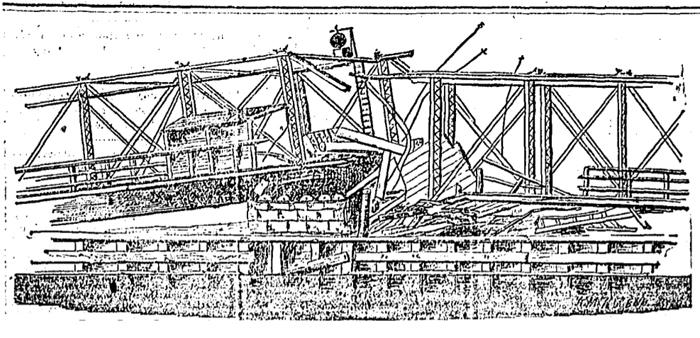Charles W. Parker
Return to Ships of John Gregory
|
Charles W. Parker US No. 125222
|
||||||||
|
Year
Built |
Last
Year |
Built At
|
Type
|
Length
|
Beam
|
Draft
|
Gross
Tons |
Net
Tons |
|
1873
|
1891
|
Chicago, IL
|
Tug
|
67.0
|
15.0
|
7.0
|
36.42
|
18.00
|
The Charles W. Parker (US No. 125222) was launched on 2 July 1873 in Chicago. She had a 67 foot keel with a 15 foot beam and a draft of 7 feet while weighing 36.42 tons gross. She was named after Charles Parker, proprietor of the Columbian Ironworks, and son of Capt. Thomas L. Parker of Oconomowoc, WI. She was built at Doolittle & Olcott’s shipyard, on the South Branch, near Van Buren street, by John Gregory of Chicago. The boiler was built by Devine, who has constructed many for the harbor tugs and whose work bears the reputation of being first-class.
The boiler of the C. W. Parker blew up at 9:35 AM on 22 September 1879 while she was about a mile and a half out from the Lincoln Park pier near the Water-Works Crib. The tug was owned by the Vessel-Owners’ Towing Company. The explosion was described as of the most sudden and terrific character, the boiler and the boat being literally blown to atoms, and of the five men who manned the tug but one escaped swift death, and he was thrown into the air fifty feet. She was valued at $5,000 at the time of the accident.
The victims of the disaster were Robert O’Leary, Captain; John Callahan, engineer; Peter Rogers, greman; and William Burton, steward all of whom have blown to pieces, and the survivor, Henry Maguire, the linesman or deckhand. Mr Maguire said that he was sitting on the fantail when the boiler blew up and was lifted off his feet and found himself in the water. It was the E. P. Ferry that picked him up. The tug, another of John Gregory’s builds, was close by and was owned by the same company.
Mr. Jacob Johnson bought the wreck and remains for $400 and rebuilt it and the boat was valued at $7,500 when she was relaunched in May of 1880. The actual rebuilding work was done by Burns and it is needless to say that is very well done.
Shortly before 9 o’clock in the morning of 22 Nov 1883, the schooner Granger (US No. 85376), lumber laden, in charge of the tug Charles W. Parker, collided with the Rush-street bridge while the latter was swung open and so damaged in the centre that the two ends sank upon the projections of the centre pier, entirely wrecking the structure and the gear in the centre.

A boiler explosion aboard the tug Charles W. Parker killed ten persons and seriously injured many others in the neighborhood of the Archer Avenue bridge on the South Branch of the Chicago River about 4:30 in the afternoon on Sunday, 4 October 1891. Three of the dead were on the tug while the others were bystanders as she along with three other tugs were engaged in attempting the tow the steamer H. S. Pickands (US No. 95836) out of the drawbridge.
Local inspectors at Chicago, Cyrus H. Sinclair and Stuart H. Moore, to James A. Dumont, supervising inspector general of steam vessel of the United States submitted a report. The inspector’s report said:
“The boat was working with a full head of steam when she blew out the crown sheet of her boiler. The boiler was found about 500 feet from the scene of the explosion, and an examination showed that it was in good condition, except that the crown sheet and stays leading to top of dome and shell had disappeared, the fusible plug being but partly melted out. Three days later, we examined the hull of the boat which had been placed in dry dock and found the missing crown sheet with nearly all of the stays attached. An examination of the engine disclosed the fact that at the time of the explosion, or an instant before it, the engine had been reversed from going ahead to backing up motion. We have made a very careful investigation of the cause leading up to this accident, and find that the captain and engineer of the boat were considered very careful, reliable and experienced men, having had years of experience in this line of work, and they both knew full well the dangers of the locality in which they were engaged. The water in this portion of the river is of a very dangerous character, owing to the proximity of the slaughter and gas houses on the river, and from the facts that we have been able to obtain it is our opinion that this accident was caused by the use of this water for making steam. The effect was to cause. the boiler to foam badly, thereby making it almost impossible for the engineer to keep the water in the boiler at the proper height. The sudden stopping and starting of the engine, if the water in the boiler was low, would be sufficient to cause this accident. This boiler was well built and if well taken care of and under ordinary condition, would have lasted a life-time.”
The Chicago Towing Company has been sued for $5,000 on account of the death of the fireman on the tug Parker, when she exploded. The main ground for the suit will be negligence in using the water of the South fork for making steam. With marine people for jurors, of course no verdict for damages could be obtained, but with people who know nothing of river business, the result of the case will be doubtful. If it were not for the supreme court to set aside these verdicts, towing companies would be bankrupted.



